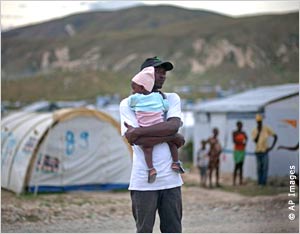
04 November 2010
U.S. Helps Haitians Brace for Storm

Washington — U.S. civilian and military personnel are helping the Haitian government prepare its people for Tropical Storm Tomas, with special concern for the more than 1 million Haitians living in temporary shelters since being displaced from their homes by the January 13 earthquake.
The Obama administration has deployed a 20-member Disaster Assistance Response Team (DART) from the U.S. Agency for International Development (USAID), and the amphibious ship USS Iwo Jima is off the Haitian coast carrying 10 helicopters and two amphibious landing craft units to help transport relief supplies to remote locations. The ship also has 1,600 medical, engineering, aviation and logistics experts onboard.
USAID’s DART team leader, Phil Gelman, told reporters via telephone November 4 that his crew is working in coordination with the Haitian government, United Nations agencies and other international partners to prepare for the storm by prepositioning supplies and conveying information on safer shelters.
“The government of Haiti has taken a leading role in a lot of the information messaging with respect to the threat to the population, and we have supported and prepositioned both personnel and resources around the country in order to be prepared,” Gelman said. That includes blankets, hygiene supplies and water containers that can be especially useful once the storm passes. In addition, he said, USAID can quickly bring additional supplies to Haiti from its warehouse in Miami.
“We want to … diminish the discomfort in the initial displacement” of Haitians to safer locations, Gelman said.
According to the National Oceanic and Atmospheric Administration (NOAA), Tropical Storm Tomas could strengthen into a hurricane late November 4 or early November 5 as it hits Haiti before moving on toward Cuba.
Gelman acknowledged that Haitian and international authorities can’t transport all of the displaced persons living in tent camps to safer locations, but said surveys inside the camps have indicated that many “do have an alternative place to go, and we hope that they exercise that option.” Aid workers are trying to transport the most vulnerable, such as women with small children, the elderly and the infirm.
Asked about the impact Tomas could have on Haiti’s cholera outbreak, Gelman said it is “rather difficult to make an informed decision” since the disease is still new to Haiti. There are countries around the world “where an increase in cholera is associated with an increase in rainfall,” while “the converse is true in other areas,” he said.
USAID’s work on hurricane preparedness in Haiti began before the hurricane season, “in full recognition of the vulnerability of the country,” Gelman said, including flood-mitigation efforts such as cleaning up drainage canals, digging drainage trenches, and terracing and shoring up hillsides in and around displaced persons camps and in key areas of Port-au-Prince.
“There has been a lot of effort … in an attempt to reduce the vulnerability of these informal settlements,” he said.
Bill Read, who directs NOAA’s National Hurricane Center, told reporters in Miami November 4 that five to 10 inches (13 to 25 centimeters) of rain is expected to fall as a result of the storm, with 15 inches (38 centimeters) in some places. He said there is concern that the high rainfall could lead to many deaths.
“The heavy rain leads to flash flooding because of the terrain, and there’s no vegetation. Once the terrain gets wet, they have mudslides … and that can bury people,” he said.
“Hopefully, as many people as possible have taken heed of the warnings and gotten out of the lowest spots,” Read said.
U.S. State Department spokesman P.J. Crowley told reporters in Washington November 4 that Haitians have been encouraged to move to 400 shelters in and around Port-au-Prince that can accommodate close to 1 million people.
The United States has positioned approximately 40,000 blankets, 16,000 hygiene kits, 32,000 water containers and 20,000 kitchen sets to be sent to the Haitian people, in addition to the supplies that are already in the country, Crowley reported.
“We have significant capacity on the ground helping Haiti now, and additional resources are standing by,” he said.
(This is a product of the Bureau of International Information Programs, U.S. Department of State. Web site: http://www.america.gov)
